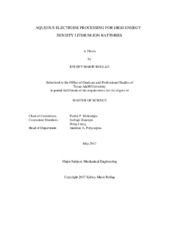| dc.description.abstract | Widespread use of electric vehicles is hinged on the advancement of energy storage technologies such as lithium-ion batteries. Current research and development endeavors in energy storage for electric vehicles are focused on increasing the energy density of a battery while simultaneously reducing manufacturing costs. Energy density can be improved by minimizing the number of inactive components in a cell with the implementation of thicker electrodes. Furthermore, cost can be significantly reduced with aqueous electrode processing. Unlike conventional electrode processing which uses the expensive and highly toxic organic solvent, N-methyl-2-pyrrolidone (NMP), aqueous processing employs deionized water. Aqueous processing of thick electrodes offers the opportunity to produce relatively inexpensive, high energy density lithium-ion batteries. However, thick aqueous processed cathodes have been found to crack as they dry.
In an effort to avoid cracking and enable aqueous processing for thick LiNi1-y-zMnyCozO2 (NMC) cathodes, the influence of two processing parameters on cracking were investigated in this work. They include solvent surface tension and electrode drying temperature. Small weight percentages of isopropanol (IPA) mixed in water were tested as novel composite solvents in aqueous processing. It was found that the addition of 20 wt.% IPA produced an aqueous solvent with a surface tension low enough to avoid any cracking in thick cathodes. When paired with a graphite anode in a single unit pouch cell, thick cathodes processed with 20 wt.% IPA as solvent performed comparably to an electrode processed with the conventional solvent, NMP. Separate experiments with electrode drying temperatures ranging from 20 °C to 70 °C revealed cracking worsens at elevated drying temperatures. Images of electrode surfaces were processed to quantify crack dimensions and crack intensity factor (CIF). Average crack length and width increased with drying temperature and electrode thickness. The CIF also increased with drying temperature and electrode thickness, the most dramatic increase being from 0.68% for thick electrodes dried at 20 °C to 15.8% when thick electrodes were dried at 70 °C. | en |


